Donkey, dingoes and flies
by Alex Wyschnja
Australian Shooter October 2002
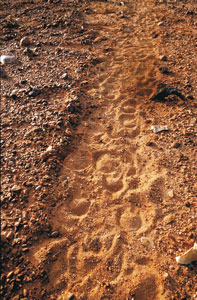 A trip to Central Australia where the possibility of encountering large game like feral donkeys has been ‘holy grail’ to my mate and me for years. A friend of ours works for a mineral exploration company and spends considerable time in Central Australia. A casual inquiry turned into a
real opportunity, as he knew a particular cattle station owner who had
a healthy population of feral donkeys, brumbies, dingoes and the odd
herd of feral camels, particularly in the inaccessible sand dune
country. The areas where feral donkeys and camels live are not like
your typical hunting paddock - it is arid, tough and remote - and any
dramas out there could quickly escalate into a life-threatening
situation.
A trip to Central Australia where the possibility of encountering large game like feral donkeys has been ‘holy grail’ to my mate and me for years. A friend of ours works for a mineral exploration company and spends considerable time in Central Australia. A casual inquiry turned into a
real opportunity, as he knew a particular cattle station owner who had
a healthy population of feral donkeys, brumbies, dingoes and the odd
herd of feral camels, particularly in the inaccessible sand dune
country. The areas where feral donkeys and camels live are not like
your typical hunting paddock - it is arid, tough and remote - and any
dramas out there could quickly escalate into a life-threatening
situation.
The logistics of hunting in the vast ‘red centre’ are daunting and careful preparation and fitness, both physical and mental, are paramount to being successful. As part of my normal exercise routine, I regularly jog five to six kilometres, four nights a week, so I was in reasonable condition. We took no risks and the troop carrier was packed to the hilt with extras, such as spare tubes, tyres, jerrycans, water, GPS units, hand held UHF radios, a good map, an EPIRB (Emergency Position Indicating Radio Beacon), and a satellite phone, just in case.
Before this trip, we had made a decision to upgrade our camping gear to include Darche superdome swags. These brilliant, dinkum Aussie bedrolls are so convenient to unroll and set up, are bug proof and make it most enjoyable to camp out under the stars. Our first night was spent on a clay-pan beside a small tree-lined creek. We were warned to keep our boots inside the swags, as cheeky dingoes are known to make off with at least one boot during the night. This was good advice since dingoes howled continuously around our camp all night - an authentic outback experience that we enjoyed immensely. It was amazing how many shooting stars could be seen while trying to get to sleep. Next morning we were up before the sun and there were fresh dingo tracks around the cold barbecue plate next to the ashes.
We drove to a small range of low hills that punctuated the gibber plains. Numerous creeks dissected these flats, providing a multitude of watering points for the cattle and other feral beasts. It was bumpy and slow going over the gibbers and we had to pick our way through some tricky dry creek crossings. I managed to take a nice black dingo bitch that trotted out of a shallow creek.
Parking the Land Cruiser under a tree near the hills, we scoured the ground for donkey tracks and droppings. Luck was with us as there were a few fresh tracks on a pad leading up into a scrubby gully. Donkeys tend to follow fixed pads when walking to water, much like cattle, sheep or goats, although they will walk anywhere when browsing or if disturbed. It was decided to climb the rocky ridge to glass the surrounding countryside. Walking towards the end of the ridge, we were thankful for a slight breeze that cooled our sweat-soaked backs and helped blow away the millions of sticky black bush flies that crawled up our nostrils and were swallowed with monotonous regularity. I’ve never seen flies like it. Forget the repellent, those damned flies used it as aftershave.
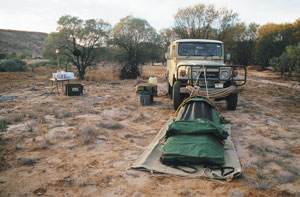
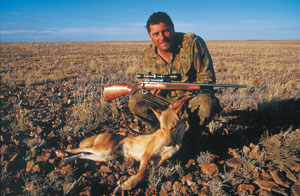
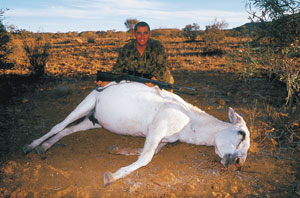
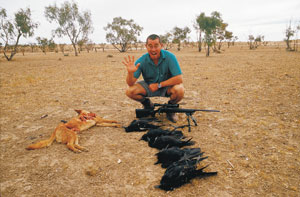 A white movement in the scrub a couple of hundred metres below
attracted our attention. A big lone jack was quietly grazing under the
trees keeping out of the now fierce sun. A short stalk down wind put us
within range and Peter quickly dispatched him with a 168gr Sierra in
the chest from his .308 all-day shooter, which is an Omark range rifle
cleverly modified to accept a 19-shot SLR magazine. It is a bit heavy,
but very quiet and when he loads the magazine to go hunting he usually
packs a water bottle and cut lunch as well.
A white movement in the scrub a couple of hundred metres below
attracted our attention. A big lone jack was quietly grazing under the
trees keeping out of the now fierce sun. A short stalk down wind put us
within range and Peter quickly dispatched him with a 168gr Sierra in
the chest from his .308 all-day shooter, which is an Omark range rifle
cleverly modified to accept a 19-shot SLR magazine. It is a bit heavy,
but very quiet and when he loads the magazine to go hunting he usually
packs a water bottle and cut lunch as well.
Ascending the ridge again we glassed the surrounding plains all the way to the horizon. About 5km out I spotted a small group of donkeys trotting along a creekbed. It was wisely decided to leave them because in a few minutes they had trotted off in the direction of a major creek intersection we called ‘four ways’.
After lunch we split up and walked along the creek in opposite directions searching for waterholes. Pocketing a GPS and tiny UHF radio I set off back towards ‘four ways’ and Peter, similarly geared up, headed down stream. Silly me got about a kilometre away when I realised I had left my ammo belt and foam pack of 20 rounds in the car. I only had four rounds in the Remington’s magazine and two in my pocket. As I came to the ‘four ways’ creek intersection, I spotted a few head of cattle under the trees - there was water close by.
Just to the left of the cattle were four donkeys sheltering in the shade. I stalked carefully over the sandy creekbed till I was about 100m from the donkeys and then let rip with a 165gr Speer Grand Slam into a big white donkey’s chest. Thump, it was a solid hit.
The remaining ferals trotted off into the scrub. Madly reloading, I now only had five rounds left, a mixture of 130gr dingo bullets and 150gr Core lokts. The donkeys didn’t travel too far. I put the Leupold’s crosshairs on the chest of another big white one and whacked it with a Core lokt at about 80m. It hardly flinched before it crashed to the ground. The other two galloped in circles in the scrub and I downed one on the run. The last donkey, a medium-grey one, trotted about 70m to the left of me and paused just for a second, allowing me to place a 130-grainer perfectly in its lower shoulder. This donkey was hit real hard and staggered only a few metres before falling over dead.
This was some of the best big game action I have ever had in my life but I was annoyed with myself for having no ammo left. Lesson learned. Inspecting the four dead animals, it was surprising how healthy and solid they were. Some of them were as big as a medium horse and would have weighed about 300kg. It took considerable effort to roll them over to inspect for bullet damage. The first one I hit with the grand slam actually staggered only a few metres before dying, as the shot was good.
Camping about two kilometres from a dam, we hoped for some morning action as the ferals had to come in for a drink in the warm weather. Peter was up early and did some reconnaissance work out at the dam before sun-up. He called me on the radio and suggested I get there soon because a sizeable mob of donkeys was on the move and seemed to be coming to water. I got moving and we waited for ages by the dam. The donkeys skirted around us and then proceeded down along the creek, right past our camp. I could have stayed in bed, sat up at the right moment and shot them from the comfort of my swag.
Much later that afternoon, we spotted another mob of ten donkeys way out in the Mitchell grass. They obviously had never encountered vehicles because we were able to quietly motor up to within 500 metres of them. We again closed the gap to within rifle range and took them out with our .308s. I had a clear side-on shoulder shot at about 200 metres on a big grey jack and used a handloaded 150gn Failsafe, which I had brought along specifically for camels. This projectile flattened the beast on the spot and exited the far-side shoulder. Failsafes are a tough bullet and ideal for this style of shooting. I also recovered some Core lokt projectiles, perfectly mushroomed under the off-side chest skin.
All of our ammo is handloaded with ADI powder using inexpensive, disposable, ex-range brass and carefully tested before field use. I felt like the early American plains buffalo hunters, shooting at long range with not a tree in sight for miles. After a hearty tea we fell into our swags comfortable in the knowledge that the .308s had now been proven on big game. It was time to look for some small game and there were plenty of dingoes about.
Next morning we checked the carcasses from the previous day; there was bound to be some hungry scavengers in for an early breakfast. The first chore though was to fix the second flat tyre for the trip before setting out. Thank goodness for the bead breaker, another essential tool in the outback.
Sure enough a big yellow dog was chewing on a dead donkey and made the fatal mistake of trotting off in a straight line directly away from us. With skills honed during countless nights shooting at foxes, Peter bowled him over on the trot with a well-placed 70gr bullet from his .243 at about 110m.
As we drove past a large dam we spotted another two dingoes coming in for water. They seemed very active in the early morning sunlight, just like foxes. Peter lay down on the bank of the dam and waited, his .243 at the ready and rock steady on its bipod. One unfortunate dog kept on coming in and Peter yelled to make it stop. Bang - whop. Another dead dingo. It was worth skinning this one because it had a beautiful pelt, which would look great tanned and hung up in Peter’s gun room. These dingoes were very lean and much tougher to skin than a fox. The most awesome thing about them is their teeth and massive jaw muscles - a real killing machine.
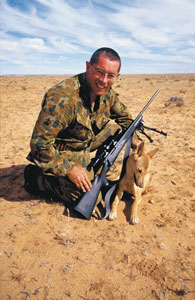 You sometimes have to make your own
luck. There were two nice yellow dingoes in the vicinity of a dry cow
carcass a few kilometres to the west. One was lying ‘doggo’ near the
carcass and it was an easy shot with my .308. The other one trotted off
but it made the fatal mistake of looking around for the danger. My shot
connected and it thrashed around in the dust for a second before lying
still. We came back later to find six wedge-tailed eagles and a swarm
of crows feeding on the two carcasses. The crows were obviously in a
feeding frenzy, as the dead dingo was hidden from view by a mass of
black feathers. Taking aim at the writhing bunch of ‘black-boys’, I
gently squeezed the Remington’s crisp trigger. To our utter amazement,
dead crows went flying in all directions. The 130gr bullet had taken
five of them.
You sometimes have to make your own
luck. There were two nice yellow dingoes in the vicinity of a dry cow
carcass a few kilometres to the west. One was lying ‘doggo’ near the
carcass and it was an easy shot with my .308. The other one trotted off
but it made the fatal mistake of looking around for the danger. My shot
connected and it thrashed around in the dust for a second before lying
still. We came back later to find six wedge-tailed eagles and a swarm
of crows feeding on the two carcasses. The crows were obviously in a
feeding frenzy, as the dead dingo was hidden from view by a mass of
black feathers. Taking aim at the writhing bunch of ‘black-boys’, I
gently squeezed the Remington’s crisp trigger. To our utter amazement,
dead crows went flying in all directions. The 130gr bullet had taken
five of them.
Our outback expedition was rapidly coming to an end and we were keen to top it off with an all-time hunt. We spotted a large mob of donkeys, at least 24 strong, browsing on a ridge in the far-off distance. We drove up to within a few kilometres and then hunted them on foot. It was real hard going, rocky, rough and hot - a fair hunt by any measure. I had a sore ankle and a blister on my left big toe but in circumstances like this you just grit your teeth and keep going.
By the time we crossed a couple of low ranges, the herd had moved and we had to walk another gruelling four kilometres to catch them. They had stopped to graze on a low flat hill that had a tiny tree-lined creek next to it. Our plan to use the creek and trees for cover worked perfectly and we got to within about 150m of the lead donkeys. There was no buck fever. After shooting all week we had the confidence to take full advantage of the power and accuracy of our .308s. I remember two shots in particular because they were both on the run, hand held and quite a distance out. One was at 290m and the other a bit closer. Both were one shot, instant kills using the tried and tested 150gr Remington Core lokt bullet. By the time the shooting had stopped only two donkeys had escaped over the hill. My foam pack of 20 rounds was nearly empty; the hunt had turned into a cull. Checking the GPS, it was quite a few painful kilometres back over the hills to the Land Cruiser, but the rush from this action had relieved the discomfort substantially.
The station owner and his wife were grateful for our tally because they had better things to do than chase ferals. We called our exploration friend on the satellite phone on the last evening of our trip. He had been flying in a chopper over the area we hunted the previous day and spotted a mob of 20 camels walking along our tyre tracks. To us, that just about summed up the unpredictability of hunting for big game in the vastness of Central Australia.
